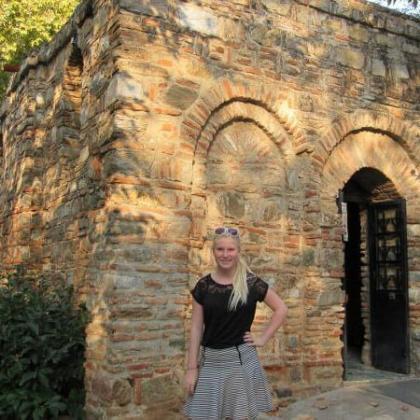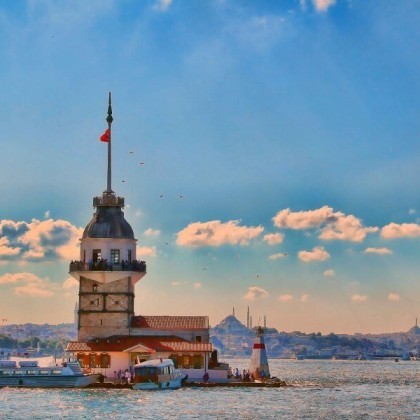Bogazkale
To locals, Boğazkale is a typical small village where ducks and cows wander oblivious to the passing tractors and children playing in the street. Its unremarkable exterior, however, is misleading: Boğazkaie is home to the 4000-year-old remains of the ruined Hittite capital of Hattuşaş. The ancient city, on the outskirts of present-day Boğazkaie, just over 200km cast of Ankara and 30km off the Samsun highway, is situated 1000m above sea level, in a gorgeous pastoral setting. A designated UNESCO world heritage site, Hattuşaş is easily navigable by car or on foot. Although much has been carted off to various museums around the world, enough of the site remains to suggest the size and glory- of the ancient city. The combination of dramatic ruins and landscapes, good places to stay and a peaceful atmosphere makes Boğazkale a unique experience in Turkey.
Istanbul New Year’s Eve Party Cruise on the Bosphorus
IstanbulWith this new year's eve party program in Istanbul, you will have an amazing new year party on the Bosphorus. Book it now and don't miss the special price!
View Tour3 Days Ephesus, Pergamon and Pamukkale Tour Package
Ephesus, Pamukkale, PergamonIf you want to make an amazing trip to the Ephesus, Pergamon, and Pamukkale, you should read our tour itinerary.
View TourIstanbul and Cappadocia Tour – 7 Days
Istanbul, Cappadocia, TurkeyIf you want to make a trip to Istanbul and Cappadocia both, we strongly suggest you join this amazing package tour. This tour covers all the accommodations, transportations, lunches...
View TourBest of Turkey Package Tour – 8 Days
Istanbul, Cappadocia, Ephesus, PamukkaleAre you looking for a good traveling package in Turkey? With our 8-days Turkey tour, you will make a trip to every important sight in Turkey. Enquire now for...
View TourThe 8 km loop passing through the Hattuşaş Hittite ruins links the main sites and makes for a beautiful hike through a wild landscape of cliffs and valleys. Three kilometers northeast of the site is Yazilikaya, an open-air temple that contains bas reliefs of 100 of the 1000 or so Human gods. Back on the main road, Boğazkale’s small but impressive museum maintains a collection of the site’s artifacts. In the last week of June, Boğazkale and nearby Çorum host a Hittite cultural festival.
TRANSPORTATION AND PRACTICAL INFORMATION
Short of renting a car, the easiest way to get to or from Boğazkale is via Sungurlu. Dolmuş leave from Boğazkale’s town square (25min.; when full 7am-5:30pm, last return 6pm; $.75). Minibuses also run on weekends. Hattuşaş Pension can arrange transport from Sungurlu or Yozgat. To get to Cappadocia, take a dolmuş to Yozgut, where you can catch a bus to Nevşehir. If you’re going from Boğazkale to a smaller destination that may not be served by Sungurlu’s small otogar, ask the dolmuş to drop you at the Mavi Ocak Tesisleri restaurant and gas station, 6km from Sungurlu and about 25km from Boğazkale on the main Sungurlu-Çorum/Samsun highway. It is a frequent rest stop for buses along the highway.
The two-lane road from Sungurlu is Boğazkale’s only real street, which inns past the museum and a few hotels before ending abruptly in the town square. Near the museum, across from the Aşıkoğlu Hotel, a separate road branches off and heads toward Hattuşaş, Yazilikaya, and two hotels (the Kale and Başkent). The Hattuşaş ticket office is one kilometer from the village center. The town square contains pharmacies, bakeries, markets, and the PIT (open M-F 8:30am-noon and 1:30pm). There is also a T.C. Ziraat Bankası that exchanges traveler’s checks. (Open daily 8:30am-noon and 1-5:30pm.) While there are currently no ATMs in Boğazkaie, there are several in Sungurlu. Next to the Aşıkoğlu Hotel, the Boğazkaie İlce Sağlık Ocağı (452 20 07) is a 24hr. clinic. There is a new internet cafe next to the Hattuşaş Pension, usually open late ($1 per hr.).
ACCOMMODATIONS AND FOOD
The area’s only restaurants are in pensions. Outside of that, your only hope for sustenance is the bakery or the grocery store.
- Hattuşaş Pension and Restaurant (452 20 13; fax 452 29 57). The only hotel In the Cumhuriyet Meydanı. 9 clean, spacious rooms, 2 with private showers and most with a view. The friendly English-speaking owner, Ahmet Baykal, is an excellent source of Information. Breakfast $1.50. Singles $7; doubles $12, with shower $14; children under 12 free.
- Kale Motel and Restaurant (fax 452 31 26). On the road to the Yazilikaya Hittite temple. Take a right out of the Boğazkale museum and another right at the Petrol Ofisi gas station. This recently renovated motel is 700m up the hill, on the left, and is a 5- 10min. walk from Yazilikaya. All rooms have baths and great balcony views. Nearby hill- top camping with stunning views and outdoor power outlets. Breakfast included. 13 rooms. Singles $7; doubles $10.
- Başkent Motel Camping (452 20 37; fax 452 25 67), on the road toward the Yazilikaya temple. 18 comfortable, decorated rooms with baths. Başkent’s campground Las all the advantages of a hilltop location. Singles $11; doubles $20; camping $4.50 per tent, with electricity $6; caravan $4.50, with electricity $6.
- Aşıkoğlu Hotel and Restaurant (452 20 04; fax 452 21 71), across from the museum, is Boğazkale’s upscale, newly renovated, modern hotel. Great, comfortable rooms at very steep prices. All rooms have their own bathroom. Internet access at ridiculous prices ($30 per hr.). Breakfast included. Hotel singles $30, motel $20; hotel doubles $40, motel $30. Camping $2.50 per tent; caravan $2.50.
THE HITTITE SITE
Expect to spend a full day exploring Yazilikaya and Hattuşaş. For more information on the Hittites, see From Hittites to Hellenes. Exploring Yazilikaya and Hattuşaş at a leisurely pace, with a break for a picnic, can easily take an entire day.
Beginning in 1600 BC, the great Hittite kings occupied Hattuşaş for four centuries, competing with Egypt for control of the fertile lands and trade routes of Mesopotamia. They conquered Syria (14th century BC) and battled Pharaoh Ramses II (1285 BC). At the same time, they ruled their civilization with a sophisticated legal code. The Hittite Empire ended around 1200 BC when Hattuşaş was burned, though historians aren’t sure exactly who destroyed the city. Possible suspects include vengeful vassals from the Black Sea and invaders from the Greek islands.
The site has two ticket kiosks, one at Hattuşaş and one at Yazilikaya. To get to the Hattuşaş kiosk, follow the road uphill toward the Başkent and Kale motels and then turn right at the Hattuşaş sign. Bring plenty of water and start early before the heat sets in. From the Hattuşaş ticket office, signs point to Yazilikaya, about 3km east. (Both sites open daily 8am-7pm; in winter 8am-6:30pm. $2. The ticket is valid for both Hattuşaş and Yazilikaya. Since Hattuşaş isn’t near any restaurants, you may want to pack a lunch.)
HATTUŞAŞ
The Hattuşaş road runs from the ticket kiosk in a 7 km loop following the city walls. Walking the loop in a counter-clockwise direction, you’ll first pass the Büyük Mabet, a temple dedicated to the weather god Hatti and the sun goddess Arinna. Today, visitors enter through or processional entrance, which originally consisted of three (a holy number to Hittites) doors separated by two pools of water. Guards standing in recesses would lay bridges down to admit worshippers. At the Büyük Mabet entrance you’ll find salesmen hawking miniature Hittite figures and souvenirs.
Farther in are the quarters of the priests, musicians, scribes, and soothsayers, as well as the temple’s warehouses, where thousands of cuneiform tablets document big commerce were found in 1907. Downhill from the temple were the offices of Assyrian merchants. Here, archaeologists found a parallel text in Akkadian and Hittite hieroglyphics that allowed scholars to translate Hittite. The smooth round holes bored into many of the stones originally held bronze rods that kept the stones together. Also, note the individual shrines to the sun goddess and the weather god, to the right of the entrance. These adjacent, rooms, the spiritual heart I of the temple, were built of special granite from a quarry over 30km away.
Up the hill, the right fork of the road passes the Hittite kings’ mined summer castle, Yenicekale, and then winds steeply up to meet the city walls. On the right is the Aslanlı Kapı, or Lion’s Gate, consisting of two crumbling doorways framed by lion statues. Only one statue survives. The grooves about a foot above the ground were for the hubs of entering chariot wheels. A photographic computer reproduction posted nearby shows what the gate might have looked like in the 13t,h century BC. Follow the restored city walls running atop the embankment up the hill to the Yer Kapı, or Ground Gate. Popularly known as the Sphinx Kapı, or Sphinx Gate (1250m above sea level), it was guarded by four sphinxes until one was taken to Berlin and another to Istanbul. Only one remains, as the fourth one has been missing since the city’s discovery. Climb up the stairs to see the site’s most intriguing feature: a 71m-long tunnel leading from inside the city walls to the outside. It was once suggested that the tunnel served a military function, allowing for surprise exits in times of siege. However, scholars now agree that it had a ceremonial function. To get a sense of the wall’s overwhelming size, walk though the tunnel, take a left, and walk about 100m along the wall to the corner staircase. Once on top, you can walk back toward the gate, the city’s highest point. From here, you can observe several razed mabet (temples) and a Byzantine church, now little more than giant blueprints marked out by limestone blocks. The plum tree to your left as you pass through Sphinx li Kapısı marks the point where the cuneiform and hieroglyphic-inscribed Bogazkale tablets, now in Ankara, were excavated
Moving eastward and downhill along the wall, the next place of interest is the Kral Kapı, or King’s Gate. The giant figure is a reproduction; the original is in the Museum of Anatolian Civilizations. Originally believed to be the gate’s namesake king, this fellow is actually a war god carrying a battle axe to symbolically defend the gate. Follow the road down a few hundred meters; on your right side are two stone chambers, each containing cuneiform characters. Unremarkable Chamber 1 is less striking than Chamber 2, 50m further down. Enter the opening opposite Nişantaş and follow the path up to a large stone, arch-shaped chamber. These were commissioned in 1200 BC by King II, the last king of Hattuşaş. The enclosed cult chamber contains a relief of the king holding a symbol with an inscription mentioning a “divine earth road,” the symbolic entrance to the underworld. Just across the road is Nişantaş, a rocky mound whose eastern side bears a badly weathered 10 line hieroglyphic inscription, believed to be a narration of the deeds of II. Last on the tour, and worth skipping if you’re short on time, is the Büyük Kale, a rained complex of archives, offices, and royal apartments linked by courtyards. This was the main fortress of the Hittite kings, and it contained most of their documents. Archaeologists found 8000 cuneiform tablets here, including a treaty between Hattuşaş II and the Egyptian Pharaoh Ramses II. Though the rains are scattered and difficult to make out, it’s easy to appreciate the size and scope of everyday city life. From here it’s 1km back to the ticket office.
YAZILIKAYA
The temple of Yazilikaya is best visited between 11am and 1pm, when the figures carved into the rock are illuminated by the sun directly overhead; shade from the towering grotto easily obscures the bas-relief deities at other times. While in later days the Hittites built large temples at this site, the holy shrine was originally only a series of narrow ravines in the rock (Yazilikaya is Turkish for “inscribed rock”). These ravines contain reliefs of gods and goddesses on parade. Goddesses appear in profile, wearing long, trailing robes; gods, most wearing kilts, face forward, with their rank indicated by the number of horns on their hats. Their are inscribed over their heads, preceded by an oval (“god” in hieroglyphics).
To the left, Chamber A consists of a long, snaking procession of gods and goddesses, increasing in rank toward the head of tire procession. Archaeologists suggest that this gallery was used to celebrate the Hittite New Year in the spring. While Hittites had over 1000 deities, most of them were adopted from pre-Hittite peoples native to the area. On the left wall, 42 male gods form a long line, at the back of which are the 12 gods of the underworld; 21 goddesses face them on the right wall. On the far wall, the sculpture culminates in the marriage of the Hittite’s two most powerful deities, Teshub, the storm god, and Hepatu, the sun goddess. Teshub is standing on the backs of two lesser gods, while Hepatu stands on a lion. To the right of Hepatu is a two-headed eagle, a symbol first used by the Hittites. Facing the procession of deities to the right of the entrance stands the famous 2.6m high relief representing King Tudhaliya IV (c.1250-1220 BC), astride two mountains and under a winged sun disk. His name appears in hieroglyphics in the bouquet like object in his right hand. The relief s peculiar white, rubbery surface is the result of a latex reproduction procedure employed by a French archaeologist. Unfortunately, latex is not meant to be used for the reproduction of outdoor reliefs, and the king’s now-damaged image -will disappear in 20-30 years. Chamber B, accessible via a narrow passage to the right of the site’s entrance, contains better preserved but less extensive reliefs. On the right wall, a relief of 12 sword carrying gods is thought to represent the 12 months of the year. Carved into the left wall is the relief of a sword, its hilt formed by 4 lions and its pommel in the shape of Nergal, god of the underworld. This chamber may have been used for the death rites of King Tudhaliya IV, who appears to the right of the sword. The niches carved into the rock were most likely used for sacrificial animal offerings.
BOGAZKALE MUSEUM
The modest Boğazkale Museum features an excellent collection of Hittite bureaucratic paraphernalia, including stone stamps, clay contract envelopes, and cuneiform deeds on stone tablets. Photographs document the progress of the dig, and a large map of the site is very helpful. Labels and explanations are in Turkish. The front desk sells the Guide to Boğazköy for $5. (Dolmuş from Sungurlu pass directly in front. 452 20 06. Open daily 8am-5:30pm. $1.25.)





